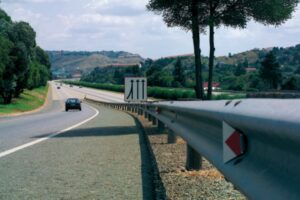Guardrail Safety: Protecting Lives on the Road

While a guardrail may cause some damage to a vehicle upon impact, it is a necessary road-safety feature that helps to prevent more serious injuries or fatalities. These safety barriers are typically observed along the edges of roads, curved mountain passes, bridges, and other areas where there is a risk of vehicles leaving the road or to protect pedestrians, other road users, and assets from errant drivers. They are seen in cities and on national roads, highways, and byways, and are specifically designed to protect lives on the road.
The Guardrail in Different Forms
There are various types and designs of these barriers, including cable guardrails, median barrier guardrails, and concrete barriers; however, the one that is most recognised internationally is the W-Beam guardrail. When these road-safety systems are installed professionally, using high-quality materials from reputable guardrail suppliers, the W-Beam steel safety barrier is one of the most effective life-saving road-safety products.
How Does a Guardrail Road-Safety System Protect Lives?
All guardrail systems are designed for the same purpose; however, the W-Beam guardrail is the most popular. Its corrugated, “W-shaped” side profile adds to its already rigid structure, making it more effective than alternative products designed for the same purpose. It is designed to accept side-on impacts from motor vehicles of varying sizes and weights that have strayed too far onto the shoulder of the road. However, it must be remembered that these structures have been designed to assist in protecting lives within legal speed limits and, if errant road users exceed these limits, the effectiveness of the equipment cannot be guaranteed.
Typically, under normal driving conditions, when a vehicle strikes the safety system, its robust frame absorbs the impact and distributes the kinetic energy along the length of the structure. In effect, it catches the vehicle in the netting of a steel band. If the vehicle is travelling at regulatory speeds, the safety net should reduce its speed, bringing it to a safe stop. This reduces the chances of serious injury and prevents the vehicle from leaving the road into a potentially more dangerous situation, like crashing into oncoming traffic, trees, or bridges; falling into ravines; or other hazards. In urban areas, they can protect the lives of pedestrians and cyclists alike.
4 Additional Ways Guardrail Road Safety Systems Protect Lives
Here are a few more ways guardrails can help protect lives:
- They Indicate Road Edges: Especially after dark, on unlit national and country roads, the reflective markings on and the light colours of the structure demarcate where the road ends.
- Assist in Preventing Roll-Overs: At regulatory speeds, upon impact, vehicles of various sizes are guided along the length of the structure, immediately reducing speeds, thus preventing roll-overs.
- Prevents Median Cluster: Barriers typically create confidence in driving ability. Motorists feel more confident in staying in their lane, preventing dangerous median clustering too close to the centre line.
- Assists in Preventing Head-On Collisions: Accidents may occur on one side of the road. W-Beam road-safety barriers prevent vehicles from transversing into opposite lanes, creating “spill-over” collisions.
Pre-Armed is Fore-Armed through Armco
At Armco Superlite, our W-Beam guardrail is produced and manufactured using the latest roadway safety barrier technology, ensuring its high durability and maximum strength. Made of high-quality steel, it can effectively reduce the impact force caused by moving road vehicles. They are available in various lengths and may be curved to fit a preferred radius from 3m to 45m. Our guardrail road-safety system is available in standard form for normal steel performance or galvanised steel for additional decades of performance.
Our internationally recognised guardrail safety systems are manufactured to SANS 1350 standards and all hot dip galvanisation procedures are completed to SANS 121 / ISO 1461 standards. In addition, our creosoted timber mounting posts conform to SANS 457 with the added benefit of preprepared holes for ease of fitting and mounting.
Contact us for superior-quality guardrail systems, including end stoppers and trend CEN end terminals. Arm yourself with Armco Superlite – internationally recognised as the leader in road-safety equipment.
